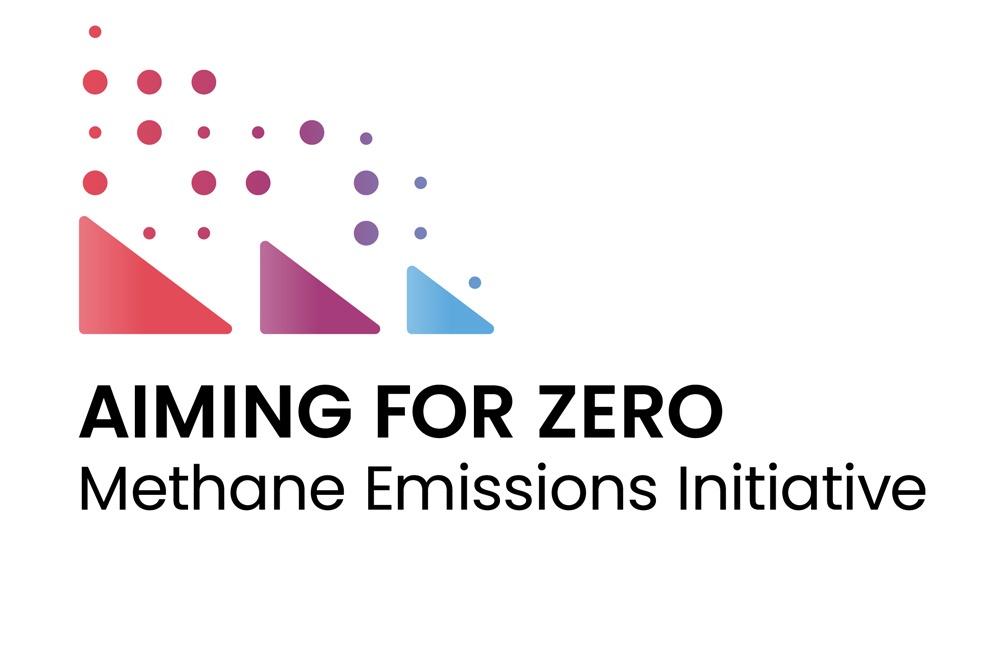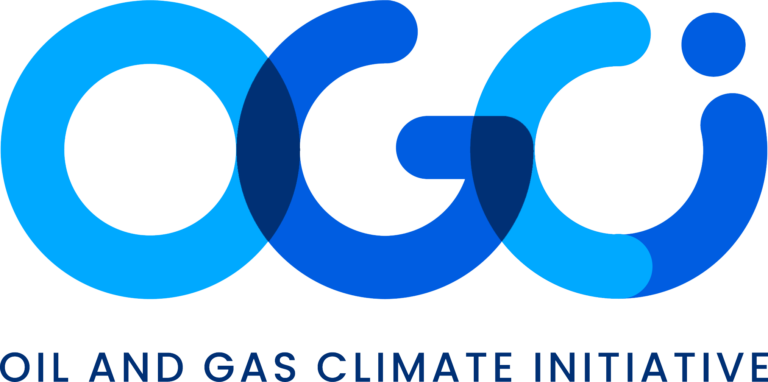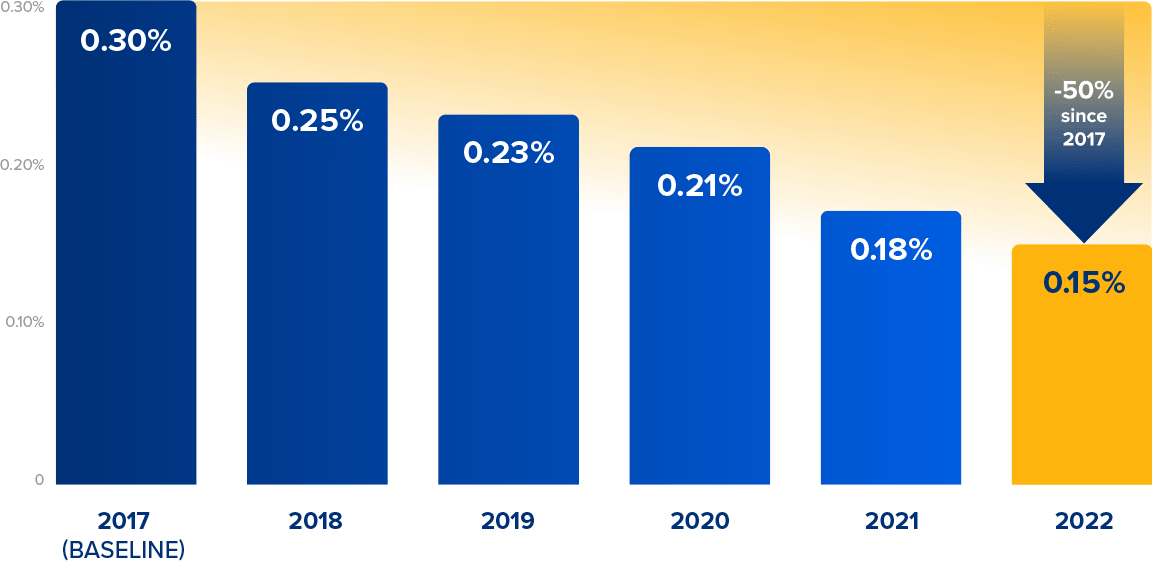When our member company CEOs launched OGCI in 2014, they highlighted the need to address methane emissions. This remains a critical issue for OGCI.
Our members have demonstrated that a significant portion of methane emissions in the oil and gas industry can be reduced at many locations at relatively low cost.
They have done this by introducing new processes, technology and equipment to mitigate leaks and avoid venting and flaring not required for safety, maintenance and mechanical integrity.
According to OGCI’s latest Performance Data, our members have collectively halved absolute upstream methane emissions, and reduced upstream flaring of greenhouse gas emissions by 45%, hitting OGCI’s collective upstream methane intensity target of well below 0.2% in 2021 — four years early.
OGCI members’ collective upstream methane intensity is now 0.15%, down from the 0.3% benchmark in 2017. The group collectively emits around 1 million tonnes of methane a year total from the global assets they operate. That compares to an estimated total of 82 million tonnes of methane emissions a year from the entire oil and gas industry1.
OGCI’s collective upstream methane intensity target of well below 0.2% is now used as a benchmark more broadly across the industry and in legislation.
For example, it was referenced in Environmental Defense Fund’s Certification White Paper (2022)2 and partially adopted in the US’s Inflation Reduction Act, which was signed into law in August 2022.3
Why methane emissions must be abated
- Methane is a more potent greenhouse gas than carbon dioxide. But it’s much shorter-lived in the atmosphere.
- Continuing to focus on reducing methane emissions can deliver a significant near-term reduction in the pace of global warming.
- The energy sector, including oil, natural gas, coal and bioenergy, accounts for nearly 40% of methane emissions from human activity. Other sources of emissions include agriculture and landfills.4
- Eliminating methane emissions from oil and gas operations is one of the quickest ways5 to accelerate progress towards the Paris Agreement climate goals.
Our members are continuing to develop processes and technological solutions to eliminate nearly all methane emissions from their own operations while engaging with other companies throughout the industry – sharing best practice, technology and building capability to enable further reductions.
OGCI members are doing this through our Aiming for Zero Methane Emissions pledge, partnerships with other initiatives such as the Methane Guiding Principles and UNEP’s Oil & Gas Methane Partnership 2.0, and a further extension of our flagship Satellite Monitoring Campaign.
OGCI collective upstream methane intensity target6
The upstream methane intensity target has helped change the way many companies address methane emissions at their operations.
Member companies have reduced upstream methane intensity from their operated oil and gas assets by an average of 17% in 2022, a decrease of 50% compared with the 2017 baseline.
OGCI member companies’ aggregate methane intensity is now 0.15%, already achieving the 2025 target of well below 0.2%. Importantly, this improvement in intensity has translated into a 50% decrease in absolute upstream methane emissions since 2017.
OGCI upstream methane intensity halves since 2017
Satellite Monitoring Campaign
New technologies, including monitoring with satellites, aircraft, drones and fixed sensors, make it easier to detect and better quantify methane emissions, allowing the oil and gas industry to address methane emissions more rapidly and systematically.
We successfully demonstrated the value of using satellite monitoring through a pilot campaign in Iraq in late 2021.
In that campaign, we commissioned GHGSat, a Climate Investment portfolio company, to collect satellite data on methane plumes over six sites in Iraq.
We then worked with GHGSat and Norwegian consultancy Carbon Limits to engage with local operators, using the data to help identify emissions sources, and sharing industry knowledge, expertise and information on potential solutions to support the operators to abate the methane emissions that were detected.
The pilot project helped one operator to address emissions at the site by rerouting part of the previously vented gas to another facility where it now powers operations.
“Reducing methane emissions from oil and gas operations to near zero will be essential to achieving the Paris Agreement ambitions and that’s why we’ve made it a priority for our work at OGCI.”
Bjørn Otto Sverdrup,
OGCI Executive Committee Chair

Investigation and abatement work is underway at three other sites where methane emissions were detected. No methane emissions were detected by GHGSat technology at the other two sites in Iraq.
Building on the success of the pilot, the campaign was extended in 2022 to additional sites in Iraq as well as new locations in Kazakhstan, Algeria and Egypt. Results from this second phase are expected later this year.
In 2023, we received the go-ahead from our members’ CEOs to expand the campaign to help more companies who aren’t members of OGCI detect and monitor methane emissions at their facilities. Our member companies then share knowledge and expertise on potential solutions to support abatement of the methane emissions that were detected. Results from this third phase are expected in 2024.
Aiming for Zero Methane Emissions
In March 2022, we launched the Aiming for Zero Methane Emissions Initiative. It is founded on the principle that companies should treat their methane emissions as seriously as they do safety incidents and strive to reach near zero from operated oil and gas assets by 2030.
Support for the initiative, which is open to the entire industry, has grown quickly. It now numbers over 90 companies. It includes private and state-run energy companies, service firms, technology providers, non-governmental organizations, and consultancies.
Signatories and supporters of Aiming for Zero recognize that virtually all methane emissions from the industry can and should be avoided.
Signatories to the initiative aim to reach near zero methane emissions from their operations by 2030, use all reasonable means to avoid methane emissions, report transparently, adopt better monitoring and measurement technologies and support the implementation of sound regulations.
Supporters endorse the initiative, encourage new signatories to join and where relevant support signatories as they reduce their methane emissions.
The initiative’s clear and straightforward ambition aims to help companies galvanize action within their organizations, fast-track the deployment, maintenance and upgrading of physical assets, and invest in new technologies and training to help reduce virtually all methane emissions.
The ambition to aim for zero methane emissions from operated oil and gas assets by 2030 is already becoming a standard reference point, as our upstream methane intensity target did before it.

OGCI pathway to near zero methane
In August 2023, OGCI published guidance on how to achieve near zero methane emissions. The guidance is designed to support operators’ efforts to reduce their methane emissions.
The guidance recommends that operators focus efforts on the most significant opportunities to mitigate methane emissions and to embrace new technologies that will help deliver continuous improvement. It sets out a four-step pathway:
- Identify potential sources of methane emissions
- Take an inventory and determine how emissions will be mitigated
- Prioritize the biggest opportunities
- Take a systematic approach
The process is designed to be implemented across a company’s business units at any asset or location, and will build on lessons learned, best practice, new technologies and existing and new regulations.
The guidance also provides examples of targets, standards and protocols for methane emissions to aid companies.
This includes relevant information from OGCI, UNEP’s reporting and mitigation program the Oil & Gas Methane Partnership 2.0, the Natural Gas Sustainability Initiative, gas certification non-profit MiQ and the World Bank.
Other OGCI initiatives to lead the industry on reducing methane emissions
We support the implementation of well-designed regulations to reduce methane emissions from existing and new sources and we’re working with international institutions, think tanks and organizations to develop programs and tools to monitor and measure methane emissions and identify abatement potential.
Our work with other methane initiatives also focuses on identifying synergies to maximize the potential and ensuring alignment to avoid duplication of efforts.
Improving identification of methane emissions
- We’re working with the Methane Guiding Principles and others to establish common industry practices to deploy technologies effectively onshore and offshore.
Detection and quantification technologies
- We have released a recommended practices guide with Ipieca and the International Association of Oil & Gas Producers (IOGP) to help operators select and deploy methane detection and quantification technologies.
- The guide includes a simple online filter to aid technology selection
Increasing scientific knowledge
- OGCI has been a primary funder of Methane Science Studies, overseen by the government-led Climate and Clean Air Coalition.7
- This work has increased scientific knowledge and understanding of methane emissions from different types of sites across the global oil and gas industry.
Reducing flaring
- Since 2020, we have supported the World Bank’s Global Gas Flaring Explorer platform to help improve transparency in flaring data from satellites.










